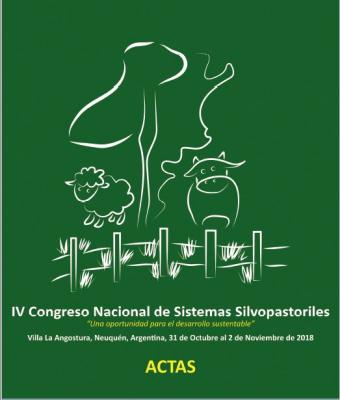Ver ítem
- xmlui.general.dspace_homeCentros Regionales y EEAsCentro Regional Tucumán - Santiago del EsteroEEA Santiago del EsteroPresentaciones a Congresosxmlui.ArtifactBrowser.ItemViewer.trail
- Inicio
- Centros Regionales y EEAs
- Centro Regional Tucumán - Santiago del Estero
- EEA Santiago del Estero
- Presentaciones a Congresos
- Ver ítem
Evaluación de rolados sin prescripciones mediante el "Índice de condición forestal” en la Región Chaqueña = Assessment of rolled chopped areas without prescriptions with the “Index of forest condition”, Chaco region
Resumen
El “rolado” es una perturbación mecánica utilizada en la región Chaqueña para desarrollar sistemas
silvopastoriles. Aplicada sin prescripciones técnicas, es criticada por no ser selectiva, simplificando la
vegetación leñosa y desbalanceando algunos procesos ecológicos. Los objetivos del presente trabajo fueron: (a) explorar el potencial del Índice de Condición Forestal (ICF) de Tucker, modificado, para evaluar grado de impacto y (b) analizar el
[ver mas...]
El “rolado” es una perturbación mecánica utilizada en la región Chaqueña para desarrollar sistemas
silvopastoriles. Aplicada sin prescripciones técnicas, es criticada por no ser selectiva, simplificando la
vegetación leñosa y desbalanceando algunos procesos ecológicos. Los objetivos del presente trabajo fueron: (a) explorar el potencial del Índice de Condición Forestal (ICF) de Tucker, modificado, para evaluar grado de impacto y (b) analizar el comportamiento del ICF en 2 comunidades roladas sin prescripciones técnicas en Santiago del Estero con Schinopsis lorentzii (Griseb.) Engl. y Aspidosperma quebracho blanco Schltdl como especies dominantes. El ICF es la suma de 5 fracciones, cuyos numeradores son: (i) área basal total (AB, m2*ha-1); (ii) diámetro promedio a la altura del pecho (Dap, cm), (iii) porcentaje de individuos con Dap < 25 cm; (iv) frecuencia de S. lorentzii (%) y (v) frecuencia de A. quebracho blanco (%), respectivamente. Como denominadores se usaron los mismos atributos observados en: (a) comunidad de referencia; (b) comunidad bajo estudio, antes de la perturbación, y (c) solo en el caso de AB, magnitud en (b) multiplicada por un factor = 0,70, ya que legalmente solo se puede aprovechar el 30 % de AB inicial. Si el ICF ≈ 5 la degradación es nula; si ICF ≈ 0, la degradación es máxima. La magnitud del ICF en las áreas roladas varió entre 4 y 5. Se considera que el ICF es apto para describir los cambios producidos por el rolado, a pesar de algunas limitaciones mejorables. Su ventaja sería la de fácil recopilación de datos para su determinación (extraible de inventarios y análisis de la vegetación). Las magnitudes observadas del ICF sugieren que el rolado no sería ‘degradante’ de la vegetación nativa leñosa bajo las condiciones de estudio.
[Cerrar]
Roller-chopping is a mechanical disturbance widely used in the Chaco region for developing silvopastoral
systems. When applied without appropriate prescriptions, it is viewed with distrust because it is not selective,
and may simplify the woody vegetation, unbalancing some ecological processes. The aims of this research were: (a) to explore the possibilities of the Tucker´s Index of Forest Condition (IFC), locally adapted, for assessing degree of
[ver mas...]
Roller-chopping is a mechanical disturbance widely used in the Chaco region for developing silvopastoral
systems. When applied without appropriate prescriptions, it is viewed with distrust because it is not selective,
and may simplify the woody vegetation, unbalancing some ecological processes. The aims of this research were: (a) to explore the possibilities of the Tucker´s Index of Forest Condition (IFC), locally adapted, for assessing degree of degradation, and (b) analyze the behavior of the ICF in two woody communities of Schinopsis lorentzii (Griseb.) Engl. And Aspidosperma quebracho blanco Schltdl as dominant species, where roller-chopping was executed without technical prescriptions. The IFC is the sum of five fractions, whose numerators are: (i) total basal area (BA, m2*ha-1),(ii) mean diameter at breast height (DBH, cm), (iii) percent of individuals below DBH = 25 cm, (iv) frequency of S. lorentzii (%) and (v) frequency of A. quebracho blanco
(%), respectively . As denominators we used the same attributes, observed in: (a) reference community; (b)
communities under study before the disturbance, and (c), the BA of (b) multiplied by a factor = 0,70, because
legally only a 30 % of the current BA could be harvested. If IFC ≈ 5, degradation is nil; while if IFC ≈ 0,
degradation is maximum. The IFC varied between 4 and 5. We considered that the IF is suitable for describing changes caused by disturbances, despite some limitations that could be improved. Its main advantage is that the information used could be gathered from vegetation inventories and analysis. The observed magnitudes of the IFC suggest that roller-chopping may not be ‘degrading’ of the woody communities under study.
[Cerrar]

Fuente
IV Congreso Nacional de Sistemas Silvopastoriles, Villa la Angostura, Neuquén, 31 de octubre al 2 de noviembre de 2018
Fecha
2018
Editorial
INTA
Formato
pdf
Tipo de documento
documento de conferencia
Palabras Claves
Derechos de acceso
Abierto
 Excepto donde se diga explicitamente, este item se publica bajo la siguiente descripción: Creative Commons Attribution-NonCommercial-ShareAlike 2.5 Unported (CC BY-NC-SA 2.5)
Excepto donde se diga explicitamente, este item se publica bajo la siguiente descripción: Creative Commons Attribution-NonCommercial-ShareAlike 2.5 Unported (CC BY-NC-SA 2.5)


